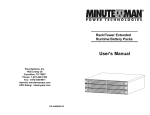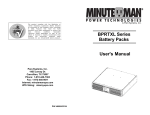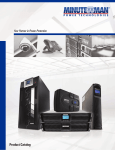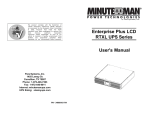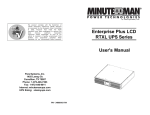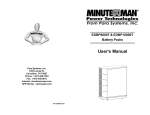Download Minuteman BP192RTXL User`s manual
Transcript
BP192RTXL BP240RTXL Battery Packs User's Manual Para Systems, Inc. 1455 Lemay Dr. Carrollton, TX 75007 Phone: 1-972-446-7363 Fax: 1-972-446-9011 Internet: minutemanups.com UPS Sizing: sizemyups.com P/N 34000472 R2 Table Of Contents 1. Introduction 2 2. Rear Panels 6 3. Installation 7 4. Operation 12 5. Replacing the Battery 12 6. Obtaining Service 18 7. Specifications 19 8. Limited Product Warranty 20 1 Chapter 1: Introduction Thank you for purchasing this power protection product. It has been designed and manufactured to provide many years of trouble free service. Please read this manual before installing your BPRTXL Battery Pack, models BP192RTXL, BP240RTXL as it provides important information that should be followed during installation and maintenance of the Battery Packs and batteries allowing you to correctly set up your system for the maximum safety and performance. Included is information on customer support and factory service if it is required. If you experience a problem with the Battery Packs please refer to Obtaining Service section in this manual to collect enough information so that the Technical Support Department can rapidly assist you. IMPORTANT SAFETY INSTRUCTIONS SAVE THESE INSTRUCTIONS ! CAUTION! This Battery Pack series is ONLY intended to be installed in an indoor temperature controlled environment that is free of conductive contaminants. This Battery Pack series is not for use in a computer room as defined in the Standard for the Protection of Electronic Computer/Data Processing Equipment ANSI/NFPA 75. Select a location which will provide good air circulation for the Battery Pack and UPS at all times. WARNING: These Battery Packs contains potentially hazardous voltages. Do not attempt to disassemble the Battery Pack beyond the battery replacement procedure. These Battery Packs contain no user serviceable parts. Repairs and Battery replacement must be performed by QUALIFIED SERVICE PERSONNEL ONLY. WARNING: Risk of Electrical Shock. Hazardous live parts inside these Battery Packs are energized from the battery. CAUTION! To de-energize the Battery Pack: 1. If the UPS is on press and release the On/Off/Test button. 2. Turn off the input breaker on the rear panel of the UPS. 3. Turn off the DC breaker on the rear panel of the Battery Pack. 4. Disconnect the battery cable from the rear panel of the UPS. 5. To de-energize the Battery Pack completely, disconnect the batteries. WARNING: Qualified Service Personnel ONLY must perform the Installation and Servicing of these Battery Packs. MINUTEMAN accepts no liabilities and is not limited to: injury to the Service Personnel, or damages to; the Battery Pack, the UPS, or the connected equipment caused by the incorrect installation or servicing of the Battery Packs. These Battery Packs MUST be operated with their respective UPS models, see the table below: Battery Pack UPS CAUTION! The maximum ambient operating temperature for this Battery Pack series is 40°C (“0 ~ 40°C” for Ambient Operation). The external vents and openings on the Battery Pack are provided for ventilation. To ensure reliable operation of the UPS and to protect the UPS from overheating, these vents and openings must not be blocked or covered. Do not insert any object into any of the vents or openings that may hinder the ventilation. Install the Battery Pack in a well ventilated area, away from excess moisture, heat, dust, flammable gas or explosives. Leave adequate space (at least 15cm) around all sides of the Battery Pack for proper ventilation. Do not mount the Battery Pack with its front or rear panel facing down at any angle. Before usage, you must allow the Battery Pack to adjust to room temperature (20°C~25°C or 68°F~77°F) for at least one hour to avoid moisture condensing inside the UPS. 2 BP192RTXL BP240RTXL ED5000RT-CU ED6000RT-CU ED8000RT-CU ED10000RT-CU CAUTION! DO NOT USE THE MOUNTING BRACKETS TO LIFT THE BATTERY PACK. The mounting brackets are ONLY for securing the Battery Pack to the rack. 3 NOTICE: This equipment has been tested and found to comply with the limits for a Class A computing device in accordance with the specifications in Subpart J of Part 15 of FCC Rules and the Class A limits for radio noise emissions from digital apparatus set out in the Radio Interference of the Canadian Department of Communications. These limits are designed to provide reasonable protection against such interference in a residential installation. This equipment generates and uses radio frequency and if not installed and used properly, that is, in strict accordance with the manufacturer's instructions, this equipment may cause interference to radio and television reception. If this equipment does cause interference to radio or television reception, which can be determined by turning the equipment off and on, the user is encouraged to try to correct the interference by one or more of the following measures: Re-orient the receiving antenna. Relocate the computer with respect to the receiver. Move the computer away from the receiver. Plug the computer into a different outlet so that the computer and receiver are on different branch circuits. Shielded communications interface cables must be used with this product. WARNING: Changes or modifications to this unit not expressly approved by the party responsible for compliance could void the user's authority to operate the equipment. RECIEVING INSPECTION Once you receive the product it should be visually inspected for damage that may have occurred in shipping. Immediately notify the carrier and place of purchase if any damage is found. Warranty claims for damage caused by the carrier will not be honored by the manufacturer. The packing materials that the product was shipped in were carefully designed to minimize any shipping damage. In the unlikely case that the product needs to be returned to the manufacturer, use the original packing material. Since the manufacturer is not responsible for shipping damage incurred when the product is returned, the original packing material is inexpensive insurance. PLEASE SAVE THE PACKING MATERIALS! 4 LIFE SUPPORT POLICY As a general policy, we do not recommend the use of any of our products in life support applications where failure or malfunction of the product can be reasonably expected to cause failure of the life support device or to significantly affect its safety or effectiveness. We do not recommend the use of any of our products in direct patient care. We will not knowingly sell our products for use in such applications unless it receives in writing assurances satisfactory to us that (a) the risks of injury or damage have been minimized, (b) the customer assumes all such risks, and (c) our liability is adequately protected under the circumstances. Examples of devices considered to be life support devices are neonatal oxygen analyzers, nerve stimulators (whether used for anesthesia, pain relief, or other purposes), auto transfusion devices, blood pumps, defibrillators, arrhythmia detectors and alarms, pacemakers, hemodialysis systems, peritoneal dialysis systems, neonatal ventilator incubators, ventilators for both adults and infants, anesthesia ventilators, and infusion pumps as well as any other devices designated as “critical” by the United States FDA. © COPYRIGHT 2014 BY PARA SYSTEMS, INC. All Rights Reserved. All rights of this User Manual (“Manual”), including but not limited to the content, information, and figures are solely owned and reserved by Para Systems, Inc. (“Para Systems”). The Manual can only be applied to the operation or the use of this product. Any disposition, duplication, dissemination, reproduction, modification, translation, extraction, or usage of this Manual in whole or in part is prohibited without the prior written permission of Para Systems. Given that Para Systems will continuously improve and develop the product, changes may be made to the information in this Manual at any time without obligation to notify any person of such revision or changes. Para Systems will make all possible efforts to secure the accuracy and the integrity of this Manual. Para Systems disclaims any kinds or forms of warranty, guarantee, or undertaking, either expressly or implicitly, including but not limited to the completeness, faultlessness, accuracy, non-infringement, merchantability or fitness for a particular purpose of the Manual. 5 Chapter 2: Rear Panels Chapter 3: Installation INSTALLATION PLACEMENT This Battery Pack series is ONLY intended to be installed in an indoor temperature controlled environment that is free of conductive contaminants. DO NOT operate the Battery Pack in: extremely dusty and/or unclean areas, locations near heating devices, water or excessive humidity, or where the Battery Pack is exposed to direct sunlight. Select a location, which will provide good air circulation for the Battery Pack at all times. Route cables so they cannot be walked on or damaged. This Battery Pack series is not for use in a computer room as defined in the Standard for the Protection of Electronic Computer/Data Processing Equipment ANSI/NFPA 75. Typical battery life is 3 to 5 years. Environmental factors do affect battery life. High temperatures, poor ventilations and frequent, short duration discharges have a negative impact on battery life. Operating Temperature (Maximum): 0 to 40°C (+32 to +104°F) Operating Elevation: 0 to 2,000m (0 to +6,562 ft) Operating and Storage Relative Humidity: 95%, non-condensing Storage Temperature: -15 to +50°C (+5 to +122°F) Storage Elevation: 0 to 15,000m (0 to +49,213 ft) 1. The DC Circuit Breaker connects and disconnects the DC bus voltage from the Battery Pack to the UPS. The DC Circuit Breaker will trip in the event of a DC overcurrent condition. 2. The top External Battery connector is for connecting to the UPS and/or for Daisy Chaining additional Battery Packs. 3. The bottom External Battery connector is for Daisy Chaining additional Battery Packs and/or connecting an external battery charger. INSTALLATION Be sure to read the installation placement and all the cautions before installing the Battery Pack. Place the Battery Pack in the final desired location and complete the rest of the installation procedure. WARNING! These Battery Packs are extremely heavy. Any time the Battery Pack has to be handled be sure to use, enough personnel, strong supports and equipment to safely handle the Battery Pack. NOTE: If you are using more than one of these Battery Packs with the Endeavor 5-10KVA RT series UPS, the UPS must be configured so that the UPS will report the correct estimated runtime on the LCD screen and in the Power Monitoring software and/or the SNMP card. See the Power Monitoring software or the SNMP card’s User's Manual to configure the UPS. CAUTION! DO NOT USE THE MOUNTING BRACKETS TO LIFT THE BATTERY PACK. The mounting brackets are ONLY for securing the Battery Pack to the rack. 6 7 RACKMOUNT CONFIGURATION Use the included rackmount brackets and screws to mount the Battery Pack in a rack by following the steps below. USE CAUTION: These Battery Packs are extremely heavy. Use two or more people when installing the Battery Pack. CAUTION! DO NOT USE THE MOUNTING BRACKETS TO LIFT THE BATTERY PACK. The mounting brackets are ONLY for securing the Battery Pack to the rack. 1. Attach the rackmount brackets to the mounting holes on the side panels of the Battery Pack as shown below. TOWER CONFIGURATION The tower configuration allows the user to install the Battery Pack in the upright position. The tower stands are provided with the Battery Pack. WARNING: Use two or more people when installing the Battery Pack. Use CAUTION, these Battery Packs are extremely heavy. 1. Once the location of the Battery Pack has been determined, place the tower stands in the desired location. WARNING: The Battery Pack must be installed in the proper up-right position. Once the Battery Pack is placed in the tower stands, looking at the front panel the the top cover of the Battery Pack MUST be on your left hand side. 2. Slide the Battery Pack into the tower stands. Make sure that the Battery Pack is stable. 3. The name plate panel can be rotated to read in the up-right position. Remove the front panel from the UPS. On the backside of the front panel, push the name plate panel outwards, the panel will pop out. Rotate the name plate panel counter clockwise so that it reads in the upright position. Reinstall the front panel on the Battery Pack. 2. Follow steps 1 through 4 to install the Battery Pack into the Rail kit. See the figure below. Step 1: Adjust the length of the rail according to the rack. Step 2: Securely tighten the wing nuts. Step 3: Secure the rail to the rack with the enclosed screws. Step 4: Slide the Battery Pack onto the rail and secure to the rack with the enclosed screws. CONNECTING THE BATTERY PACK (QUALIFIED SERVICE PERSONNEL ONLY) Please read all of the WARNINGS and CAUTIONS before attempting to connect or service the batteries or the Battery Pack. The installation and servicing of the batteries and the Battery Pack must be performed by Qualified Service Personnel ONLY. Replace the batteries and/or Battery Pack with the same number and type as originally installed. CAUTION: Do not open or mutilate batteries. Released electrolyte is harmful to the skin and eyes and may be toxic. CAUTION: Do not dispose of batteries in a fire. The batteries may explode. 8 9 NOTE: If you are using more than one of these Battery Packs with the Endeavor 5-10KVA RT series UPS, the UPS must be configured so that the UPS will report the correct estimated runtime on the LCD screen and in the Power Monitoring software and/or the SNMP card. See the Power Monitoring software or the SNMP card’s User's Manual to configure the UPS. 1. The UPS MUST be in the off position. 2. The DC breaker(s) on the rear panel of the Battery Pack(s) MUST be in the off position. 3. Remove the External Battery Connector's cover plate from the rear panel of the UPS (requires a phillips screwdriver). 4. Remove the top External Battery Connector's cover plate from the rear panel of the Battery Pack. 5. Connect the one end of the #8 AWG premolded battery cable to the External Battery Connector on the rear panel of the UPS and secure with the retaining screws. 6. Connect the other end of the #8 AWG premolded battery cable to the External Battery Connector on the rear panel of the Battery Pack and secure with the retaining screws. 7. Turn on the DC breaker on the rear panel of the Battery Pack. 8. The Battery Pack is ready for normal operation, see the UPS User's Manual for the normal startup of the UPS. NOTE: If using more than one Battery Pack see Daisy Chaining. 4. Remove both of the External Battery Connector's cover plates from the rear panel of the first Battery Pack. 5. Remove the top External Battery Connector's cover plate from the rear panel of the second Battery Pack. 6. Connect the first #8 AWG premolded battery cable to the External Battery Connector on the rear panel of the UPS and secure with the retaining screws. 7. Connect the other end of the first #8 AWG premolded battery cable to the External Battery Connector on the rear panel of the first Battery Pack and secure with the retaining screws. 8. Connect the second #8 AWG premolded battery cable to the bottom External Battery Connector on the rear panel of the first Battery Pack and secure with the retaining screws. 9. Connect the other end of the second #8 AWG premolded battery cable to the top External Battery Connector on the rear panel of the second Battery Pack and secure with the retaining screws. 10. Turn on all of the DC breakers on the rear panel of the Battery Packs. 11. The Battery Packs are ready for normal operation, see the UPS User's Manual for the normal startup of the UPS. NOTE: There is no maximum number for Daisy Chaining the Battery Packs, however the recharge time will increase exponentially for every Battery Pack added. DAISY CHAINING (QUALIFIED SERVICE PERSONNEL ONLY) "Daisy Chaining" means connecting one Battery Pack to another Battery Pack to another Battery Pack, this chain could go on indefinitely. Follow the steps below to Daisy Chain the Battery Packs. Please read all of the WARNINGS and CAUTIONS before attempting to connect the external battery pack. 1. The UPS MUST be in the off position. 2. The DC breakers on the rear panel of the Battery Packs MUST be in the off position. 3. Remove the External Battery Connector's cover plate from the rear panel of the UPS (requires a phillips screwdriver). 10 11 Chapter 4: Operation Replace the batteries and/or Battery Pack with the same number and type as originally installed. SYSTEM OVERVIEW These Battery Packs will extend the runtime capabilities of the UPS. These Battery Packs do not have internal chargers and are charged by the UPS to properly maintain the batteries. There is no maximum number for Daisy Chaining the Battery Packs, however the recharge time will increase exponentially for each Battery Pack added. NOTE: If you are using more than one of these Battery Packs with the Endeavor 5-10KVA RT series UPS, the UPS must be configured so that the UPS will report the correct estimated runtime on the LCD screen and in the Power Monitoring software and/or the SNMP card. See the Power Monitoring software or the SNMP card’s User's Manual to configure the UPS. CAUTION: Do not open or mutilate batteries. Released electrolyte is harmful to the skin and eyes and may be toxic. CHARGING THE BATTERY These Battery Packs do not have internal chargers. The Battery Packs are charged by the UPS. It is recommended that the Battery Packs be charged for a minimum of 4-hours before use. The Battery Pack maybe used immediately, however, the “On-Battery” runtime of the UPS may be less than normally expected. NOTE: If the Battery Pack is going to be out of service or stored for a prolonged period of time, the batteries must be recharged for at least 24hours every ninety days. TURNING THE BATTERY PACK ON/OFF Turning on the DC circuit breaker on the rear panel of the Battery Pack will connect the DC bus voltage from the Battery Pack to the UPS. Turning off the DC circuit breaker on the rear panel of the Battery Pack will disconnect the DC bus voltage from the Battery Pack to the UPS. Chapter 5: Replacing The Battery (QUALIFIED SERVICE PERSONNEL ONLY) Please read all of the WARNINGS and CAUTIONS before attempting to connect or service the batteries or the Battery Pack. The installation and servicing of the batteries and the Battery Pack must be performed by Qualified Service Personnel ONLY. Typical battery life is 3 to 5 years. Environmental factors do affect battery life. High temperatures, poor utility power, and frequent, short duration discharges have a negative impact on battery life. NOTE: If there is a power interruption while replacing the batteries, with the UPS on, the load will not be backed up. CAUTION: Do not dispose of batteries in a fire. The batteries may explode. The batteries in these Battery Pack are recyclable. Dispose of the batteries properly. The batteries contain lead and pose a hazard to the environment and human health if not disposed of properly. Refer to local codes for proper disposal requirements or return the battery to the supplier. CAUTION: The battery can present a risk of electrical shock. These batteries produce sufficient current to burn wire or tools very rapidly, producing molten metal. Observe these precautions when installing or replacing the batteries: 1. Remove watches, rings, or other metal objects. 2. Use hand tools with insulated handles. 3. Wear protective eye gear (goggles), rubber gloves and boots. 4. Do not lay tools or other metal parts on top of batteries. 5. Disconnect the charging source prior to connecting or disconnecting the battery terminals. 6. Determine if the battery is inadvertently grounded. If the battery is, remove the source of the grounding. Contact with any part of a grounded battery can result in an electrical shock. The likelihood of such shock will be reduced, if such grounds are removed during installation and maintenance. CAUTION: Replace the batteries with the same number and type as originally installed in the Battery Pack. These batteries have pressure operated vents. These Battery Packs contain sealed non-spillable maintenance free lead acid batteries. Model BP192RTXL BP240RTXL Battery B00056 B00058 WARNING! This Battery Pack contains potentially hazardous voltages. Do not attempt to disassemble the Battery Pack beyond the battery replacement procedure. These Battery Packs contain no user serviceable parts. 12 13 BATTERY REPLACEMENT PROCEDURE (QUALIFIED SERVICE PERSONNEL ONLY) PLEASE READ THE CAUTIONS AND WARNINGS BEFORE ATTEMPTING TO REPLACE THE BATTERY MODULES The batteries can be replaced without powering down the whole UPS system. NOTE: If there is a power interruption while replacing the batteries, with the UPS on, the load will not be backed up. To replace the batteries without powering down the UPS system start with step number 6. 24. Properly dispose of the old batteries at an appropriate recycling facility or return them to the supplier in the packing material for the new batteries. 25. The Battery Pack is ready for normal operation. NOTE: If the UPS has a Weak/Bad Battery Alarm after replacing the batteries, the user must initiate a self-test to clear the Weak/Bad Battery Alarm. To initiate a self-test see section 4 "ON / OFF/ TEST BUTTON" in the UPS's User's Manual. BP240RTXL 1. Turn off the equipment that is plugged into the output receptacles of the UPS. 2. Press and release the On/Off/Test button on the front panel to turn the UPS off. 3. Disconnect the UPS from the utility power. 4. Unplug the equipment from the output receptacles of the UPS. 5. Unplug the computer interface cable from the rear panel of the UPS. 6. Turn off all of the DC circuit breakers on the rear panel of all of the Battery Packs. 7. Disconnect all of the battery cables. 8. Remove the Battery Pack from the rack and lay on the floor or a tabletop. USE CAUTION: These Battery Packs are extremely heavy. Use two or more people when removing the Battery Pack. 9. Remove the cover screws from the top cover. 10. Remove the cover and set aside. 11. Remove the retaining screws for the battery retaining brackets. 12. Remove the battery retaining brackets and set aside. NOTE: Before disconnecting the battery wires it is recommended that you draw a diagram of how the batteries are connected. 13. Disconnect the battery positive (red) and battery negative (black) wires. 14. Disconnect all of the battery wires. 15. Remove all of the defective batteries and set aside. 16. Install the new batteries in the same orientation as the original batteries. 17. Verify proper polarity. Re-install the battery wires. 18. Reconnect the battery positive (red) and battery negative (black) wires. 19. Re-install the battery retaining brackets and secure with the retaining screws. 20. Re-install the top cover and secure with the retaining screws 21. Re-install the Battery Pack in the rack. 22. Reconnect all of the battery cables. 23. Turn on all of the DC circuit breakers on the rear panel of all of the Battery Packs. 14 15 BP192RTXL (QUALIFIED SERVICE PERSONNEL ONLY) 1. Turn off the equipment that is plugged into the output receptacles of the UPS. 2. Press and release the On/Off/Test button on the front panel to turn the UPS off. 3. Disconnect the UPS from the utility power. 4. Unplug the equipment from the output receptacles of the UPS. 5. Unplug the computer interface cable from the rear panel of the UPS. 6. Turn off all of the DC circuit breakers on the rear panel of all of the Battery Packs. 7. Disconnect all of the battery cables. 8. Remove the Battery Pack from the rack and lay on the floor or a tabletop. USE CAUTION: These Battery Packs are extremely heavy. Use two or more people when removing the Battery Pack. 9. Remove the front panel retaining screws. 10. Remove the front panel and set aside. 11. Remove the cover screws from the top cover. 12. Remove the cover and set aside. 13. Remove the retaining screws for the battery retaining bracket. 14. Remove the battery retaining bracket and set aside. NOTE: Before disconnecting the battery wires it is recommended that you draw a diagram of how the batteries are connected. 15. On the right hand side at the rear find the Anderson connector holder box. Open the box and disconnect the battery positive (red) and battery negative (black) Anderson connectors. 16. On the left hand side in the middle find the Anderson connector holder box. Open the box and disconnect the Anderson connectors. USE CAUTION: The battery modules are heavy. 17. Slide the front battery module out and set on a tabletop. 18. Slide the rear battery module out and set on a tabletop. 19. Open the battery modules one at a time. 20. Disconnect all of the battery wires. 21. Remove all of the defective batteries and set aside. 22. Install the new batteries in the same orientation as the original batteries. 23. Verify proper polarity. Re-install the battery wires. 24. Re-install the battery modules. 25. Reconnect the Anderson connector on the left hand side. Re-install the Anderson connector holder box. 26. Reconnect the Anderson connectors on the right hand side. Re-install the Anderson connector holder box. 27. Re-install the battery retaining bracket and secure with the retaining screws. 28. Re-install the top cover and secure with the retaining screws 29. Re-install the front panel and secure with the retaining screws. 30. Re-install the Battery Pack in the rack. 16 31. Reconnect all of the battery cables. 32. Turn on all of the DC circuit breakers on the rear panel of all of the Battery Packs. 33. Properly dispose of the old batteries at an appropriate recycling facility or return them to the supplier in the packing material for the new batteries. 34. The Battery Pack is ready for normal operation. NOTE: If the UPS has a Weak/Bad Battery Alarm after replacing the batteries, the user must initiate a self-test to clear the Weak/Bad Battery Alarm. To initiate a self-test see section 4 "ON / OFF/ TEST BUTTON" in the UPS's User's Manual. 17 Chapter 6: Obtaining Service Chapter 7: Specifications IF THE BATTERY PACK REQUIRES SERVICE SYSTEM SPECIFICATIONS Model Number 1. Verify there are no tripped circuit breakers and that the batteries are good. A tripped circuit breaker and defective batteries are the most common issues. 2. Call your dealer for assistance. If you cannot reach your dealer, or if they cannot resolve the issue call or fax the Technical Support department at the following numbers; Voice phone (972) 446-7363, FAX line (972) 446-9011 or visit our Web site at www.minutemanups.com the "Discussion Board". Before calling the Technical Support Department have the following information available: a) Contact name and address. b) Where and when the unit was purchased. c) All of the model information about your unit. d) The serial number of your unit. e) Any information on the failure, including LEDs that may be illuminated or error codes displayed. f) A description of the protected equipment including model numbers, if possible. g) A technician will ask you for the above information and if possible, help solve the issue over the phone. In the event that the unit requires factory service, the technician will issue you a Return Material Authorization Number (RMA #). h) If the unit is under warranty, the repairs will be done at no charge. If the unit is not under warranty there will be a charge for the repair. 3. Pack the unit in its original packaging. If the original packaging is no longer available, ask the Technical Support Technician about obtaining a new set. It is important to pack the unit properly in order to avoid damage in transit. Never use Styrofoam beads for a packing material. a) Include a letter with your name, address, day time phone number, RMA number, a copy of your original sales receipt, and a brief description of the problem. 4. Mark the RMA # on the outside of all packages. The factory cannot accept any package without the RMA # marked on the outside. 5. Return the unit by insured, prepaid carrier to: BP240RTXL Rack/Tower Convertible BATTERY SYSTEM Battery Type Typical Recharge Time Typical Battery Life System Voltage DC Current Battery Quantity Battery Part Number Sealed, Non-Spillable, Maintenance Free, Value Regulated, Lead Acid 8-hours to 90% after full load discharge 3-5 years, depending on discharge cycles and ambient temp 192VDC 240VDC 35.7 Amps 39.2 Amps 16 20 B00056 B00058 Battery Cable Type Premolded #8 AWG Battery Cable Length Output Protection 21" / 533.4mm Resettable Circuit Breaker ENVIRONMENTAL 0 to 40°C (+32 to +104°F) Operating Temperature (max) Storage Temperature -15 to +50°C (+5 to +122°F) 95% Non-Condensing Operating/Storage Humidity Operating Elevation Storage Elevation 0 to 2,000m (0 to +6,562 ft) 0 to 15,000m (0 to +49,213 ft) PHYSICAL Size - Net LXWXH Weight - Net Size - Shipping LXWXH Weight - Shipping 25.2 x 17.3 x 3.5" 640 x 440 x 89 mm 23.4 x 17.3 x 5.14" 595 x 440 x 130.6 mm 80.5 lbs 36.5 Kgs 134.5 lbs 61.0 Kgs 31.5 x 23.6 x 9.1" 800 x 600 x 230 mm 122.4 lbs 55.5 Kgs 29.5 x 23.6 x 10.9" 750 x 600 x 276 mm 172.0 lbs 78.0 Kgs REGULATORY COMPLIANCE Safety and Approvals EMC Verification Para Systems Inc. MINUTEMAN UPS 1809 W. Frankford Road, Suite 150 Carrollton, TX 75007 ATTN: RMA # _______ BP192RTXL Format cTUVus (Conforms to UL1778 4th Edition & CSA 22.2 no. 107.3-05) FCC Class B, CE certified NOTE: These Battery Packs do not have internal chargers. The typical recharge time is based on the UPS charging the batteries. NOTE: Specifications are subject to change without notice. 18 19 Chapter 8: Limited Product Warranty Para Systems, Inc. (Para Systems) warrants this equipment, when properly applied and operated within specified conditions, against faulty materials or workmanship for a period of three years from the date of purchase. For equipment sites within the United States and Canada, this warranty covers depot repair or replacement of defective equipment at the discretion of Para Systems. Depot repair will be from the nearest authorized service center. The customer pays for shipping the product to Para Systems. Para Systems pays ground freight to ship the product back to the customer. Replacement parts and warranty labor will be borne by Para Systems. For equipment located outside of the United States and Canada, Para Systems only covers faulty parts. Para Systems products that are depot repaired or replaced pursuant to this warranty shall only be warranted for the unexpired portion of the warranty applying to the original product. This warranty applies only to the original purchaser who must have properly registered the product within 10 days of purchase. Notes: The warranty shall be void if (a) the equipment is damaged by the customer, is improperly used, is subjected to an adverse operating environment, or is operated outside the limits of its electrical specifications; (b) the equipment is repaired or modified by anyone other than Para Systems or Para Systems approved personnel; or (c) has been used in a manner contrary to the product’s User's Manual or other written instructions. Any technical advice furnished before or after delivery in regard to use or application of Para Systems’ equipment is furnished without charge and on the basis that it represents Para Systems’ best judgment under the circumstances, but it is used at the recipient’s sole risk. EXCEPT AS PROVIDED HEREIN, PARA SYSTEMS MAKES NO WARRANTIES, EXPRESSED OR IMPLIED, INCLUDING WARRANTIES OF MERCHANTABILITY AND FITNESS FOR A PARTICULAR PURPOSE. Some states do not permit limitation of implied warranties; therefore, the aforesaid limitation(s) may not apply to the purchaser. EXCEPT AS PROVIDED ABOVE, IN NO EVENT WILL PARA SYSTEMS BE LIABLE FOR DIRECT, INDIRECT, SPECIAL, INCIDENTAL, OR CONSEQUENTIAL DAMAGES ARISING OUT OF THE USE OF THIS PRODUCT, EVEN IF ADVISED OF THE POSSIBILITY OF SUCH DAMAGE. Specifically, Para Systems is not liable for any costs, such as; labor for on-site installation, on-site maintenance or on-site service, lost profits or revenue, loss of equipment, loss of use of equipment, loss of software, loss of data, cost of substitutes, claims by third parties, or otherwise. The sole and exclusive remedy for breach of any warranty, expressed or implied, concerning Para Systems’ products and the only obligation of Para Systems hereunder, shall be depot repair or replacement of defective equipment, components, or parts; or, at Para Systems’ option, refund of the purchase price or substitution with an equivalent replacement product. This warranty gives you specific legal rights and you may also have other rights which vary from state to state. No employee, salesman, or agent of Para Systems is authorized to add to or vary the terms of this warranty. 20 21













